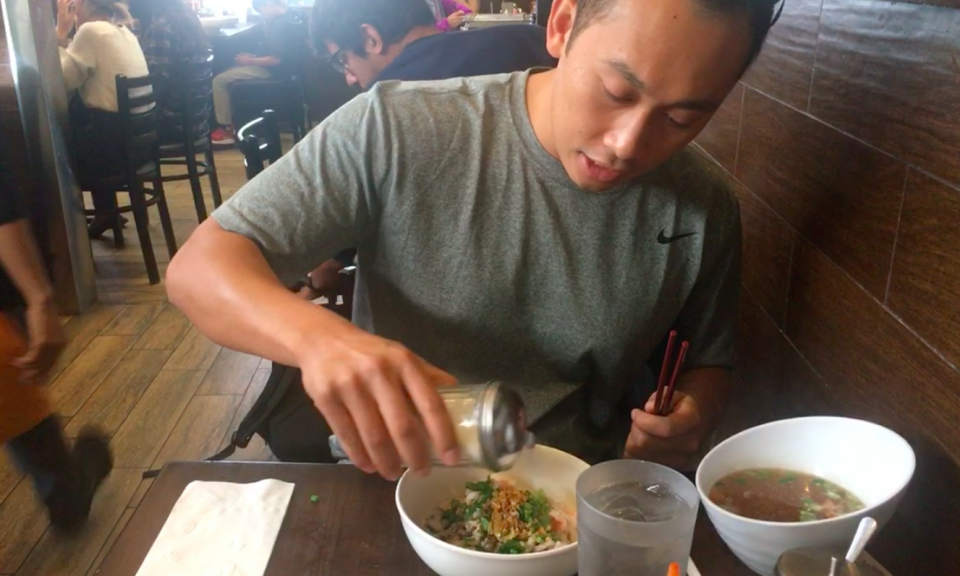Long Beach California’s Cambodian community shares a lot in common – not least a history of pain. Forged in the 1970s and 80s by refugees from the war in their home country, where a genocide claimed up to three million people in only four years, Cambodia Town as it is now known was born from tragedy.
Even for the second generation, who now make up the bulk of Long Beach’s 20,000-plus Cambodians, life was not easy growing up. They came of age under the weight of their parents’ often-silent suffering and had to find a place for themselves in what was then a neglected, dangerous neighborhood riven by gang violence.
From the beginning, food was integral to Cambodia Town: as a kind of centripetal force drawing the community together; as a way to show love; and, most importantly of all, as a means to survive. Now, a new generation are hoping to use food to usher in a new era for Cambodia Town and to bring attention to their vibrant culture.
Cambodia Town — a designated 1.2-mile section of Anaheim Street between Atlantic and Junipero Avenues — boasts one of the largest concentrations of Cambodians outside of South East Asia. Today, crime and violence are mostly a memory, and lines of young Cambodians and curious food lovers from all over Southern California flock to the neighborhood’s restaurants.
There is more to be done, though. The area’s young residents feel that it’s time for Cambodian culture and cuisine to take their place alongside the culture and cuisine of other Southeast Asian countries such as Thailand and Vietnam. They want to elevate and modernize their food – and to use it to shine a light not just on traditional Khmer culture but on the unique experience of Cambodians in America.
Van Tan is the co-owner of Phnom Penh Noodle Shack, which is likely the area’s most popular restaurant — thanks to a loyal following of local Cambodians and glowing coverage in the Los Angeles Times.
Tan was born in a refugee camp in Thailand, but his first memories are of Long Beach where his family relocated when he was just one year old. Today, his restaurant is bright and airy. Its façade is inevitably obscured by queues around the block, with everyone waiting for a bowl of “the shack’s” famous noodle soup.
It was nothing like this when Van’s aunt first opened shop more than 30 years ago. Starting out life in an old greasy spoon diner in a rough part of town, the original Phnom Penh Noodle Shack was one of the first Cambodian restaurants in the United States. It was much smaller than the current recently-expanded location, grimier, and stifling too, with only one malfunctioning air conditioning unit and a kitchen that took up almost half of the restaurant.
Still, what Tan remembers from those days is not the heat, the cramped space, or the dirt. “I would see the elder generation, they would come here, congregate and get a bowl of noodles or some porridge. And even though it was really rough, they just loved it. It made them feel comfortable,” he says, waiting for the server to bring him his own noodles. “This place was like a refuge for those people who lost something back in Cambodia … Over the years, and as time goes on, I feel that here they found some sort of healing or peace in this new country.”
The food in Cambodia Town then tended to be basic, rural fare. “When they migrated over from Cambodia they needed to find a way to make money, and coming from a small farming community this is what they knew,” says Tan of his family. “They’d never dabbled in the restaurant business but when times are tough, you’re going to find a way.”
There’s rarely a quiet moment at the Phnom Penh Noodle Shack. Photo: Charley Lanyon
Those migration demographics are responsible in part for Cambodian cuisine’s reputation in America today as the more rough-hewn cousin of Thai and Vietnamese food. It didn’t help that so many of those first-generation restaurateurs, in a bid to draw customers who may have been unfamiliar with Cambodian food, actually advertised their restaurants as serving Thai or Vietnamese. Even today, many of the neighborhood’s proudly Cambodian eateries still have names like Sophy’s Fine Thai & Cambodian Cuisine, or Crystal Thai-Cambodian Cuisine. Restaurant naming conventions remain a point of consternation for the new generation of Long Beach residents who feel Cambodian cuisine has been prevented from getting its due.
Maurice Yim, a classically trained chef and the owner of Le Aw – a catering company which specializes in modern, even molecular, takes on Khmer cuisine – says that we have it all wrong when it comes to his people’s food. Far from being a lesser version of the food of Thailand or Vietnam, Cambodian cooking combines the best from all over South East Asia, he says. “It has the strong bold flavors of Thai food plus the fresh herbal flavors of Vietnamese food.”
Sophy’s is one of Cambodia Town’s best-loved spots. Photo: Charley Lanyon
Cambodian food also boasts flavors wholly unique to the country. Two ingredients that remain mostly foreign to American palates form its bedrock: prahok, an intensely funky, pungent fermented fish paste that Lim describes as “like a mud fish that’s been left to sit until it breaks down into a paste,” and kroeung, another paste, this time made from lemongrass, ginger and herbs, that provides the foundation of many if not most Khmer dishes. Each family’s kroeung is different and Cambodians are fiercely loyal to the paste of their childhood.
Still, even with American diners now more adventurous than ever before, cooking proper Khmer food for western tastes can be a challenge. For the most part, ingredients are easy to find – thanks to the neighborhood’s well-stocked Cambodian markets and Southern California’s embarrassment of super-fresh produce, which caters to the area’s diverse ethnic communities. But even with great ingredients, there is, as they say, no accounting for taste.
Tan was shocked on a recent trip to Cambodia to discover how much MSG chefs there use and says that, in his restaurant, he only uses about 5% of the MSG called for in traditional recipes. For his part, Yim says many chefs, himself included, have had to tone down traditional Cambodian flavors to appeal to a wider audience here. The first hurdle, he says, is the fish paste: “People might be turned off by it so a lot of restaurants here either don’t use it or use very little of it.” An unimaginable transgression back in Cambodia.
And then there are the changing tastes across generations of American Cambodians to consider. Yim trained at Le Cordon Bleu and is enamored with French techniques. His favorite dish at Sophy’s — one of the community’s most beloved restaurants — is a salad of raw salmon in a citrus vinaigrette, a fusion dish that would be unheard of in Cambodia.
Like most Cambodians, he often gets a craving for Amok, a kind of steamed fish-based soufflé and a prime example of Khmer comfort food. But when Yim serves Amok at his pop-up events in Los Angeles he will use local, seasonal Southern Californian ingredients, and plate it on rice in a modernist tower topped with dehydrated vegetable crisps and maybe even a dash of that old standby of molecular gastronomy, liquid nitrogen.
Tan doesn’t dabble with liquid nitrogen but his tastes are just as much a product of his American upbringing. When he orders noodles at his own restaurant he goes off-menu, ordering them dry with the broth on the side, then covering them with a layer of granulated sugar and lashings of every condiment on offer until the hot noodles are covered in a kind of fragrant shellac. His innovation is certainly delicious — especially when chased with gulps of the steaming broth — but it would likely leave Cambodian noodle connoisseurs in the old country shaking their heads.
Even for some in Long Beach, though, there is simply no substitute for the original. While enjoying our dried beef, fish-based noodle soup with fragrant kroeung, and Yim’s beloved salmon salad, an employee at Sophy’s interrupted our conversation: “If you want real Cambodian food you have to get on a plane,” he said. “At my sister’s house in Cambodia the food is so fresh that you wouldn’t believe it.” He told us that he had bought land near her and planned to retire there. “You can still eat ant eggs, and have a salad made from fresh mud crabs pulled straight from the rice fields.”
Where to find great Cambodian Food in Long Beach’s Cambodia Town
Phnom Penh Noodle Shack
1644 Cherry Ave, Long Beach, CA 90813 Tel: 562-433-0032, thenoodleshack.com
The oldest, most beloved, and thanks to lots of media coverage, most popular Cambodian restaurant in Long Beach. The noodle soup is the move here. Make sure you ask for a shank bone in your broth to gnaw on when you’re finished. Also, the iced coffees are seriously awesome.
Little La Lune Cuisine
2054 E Pacific Coast Hwy, Long Beach, CA 90804 Tel: 562-856-5800, littlelalune.com
More than just the place to go if the line at Phnom Penh is too daunting, Little La Lune serves up some of the best soup broth we’ve ever tasted anywhere and the Chinese-style fried dough will have carb fans weeping into their noodles. For a traditional Khmer breakfast, try their porridge with pig’s blood.
Crystal Thai-Cambodian Cuisine
1165 E 10th St, Long Beach, CA 90813 Tel: 562-591-7636
Crystal boasts a comprehensive menu covering all facets of Cambodian cuisine. Don’t be overwhelmed: do as the locals do and stick to their justifiably famous soups and special occasion-worthy whole fish, perfect for sharing.
Sophy’s Fine Thai & Cambodian Cuisine
3240 E Pacific Coast Hwy, Long Beach, CA 90804 Tel: 562-494-1763
The second-largest Khmer restaurant in Long Beach, Sophy’s acts as a kind of unofficial community center for the neighborhood. Their fried, dried beef is the perfect accompaniment to a cold beer. If you love the funk, their prahok with ground pork is famous for a reason.
Monorom Cambodian Restaurant
2150 E Anaheim St, Long Beach, CA 90804 Tel: 562-434-1919, monoromcambodian.com
This Cambodia Town standby is beloved for its grilled meats. Their beef sticks are a must-order, served with a crisp refreshing side of fresh cucumber and green papaya. Another dish that calls out for a cold one.
Recipe for Cambodian Beef Sticks, LBC-Style, by Maurice Yim
This traditional Khmer street-snack has been given a distinctly SoCal makeover thanks to ingredients by way of Mexico and Korea.
2 lbs beef chuck or top round, thinly sliced
For the kroeung [lemongrass paste]:
2 stalks lemongrass; 3 cloves garlic
1 large shallot
1 tsp turmeric
1 inch galangal
3 kaffir lime leaves
For the marinade:
4 tbl oyster sauce
3 tbl fish sauce
1 tsp paprika
4 tbl (or to taste) brown sugar
1 tbl gochugaru or 2 dried ancho chilies (seeded and soaked until soft)
1 tbl gochujang
2 tbl coconut milk
1 tbl neutral oil
First, add all kroeung ingredients into a food processor until a paste is formed.
Next, add the kroeung and marinade ingredients into a blender and finely process. Mix and coat beef with marinade for 2 hours minimum, or overnight for best results. After it’s been marinated, skewer the beef onto sticks, and grill on high heat to desired doneness. Serves 2-4.



